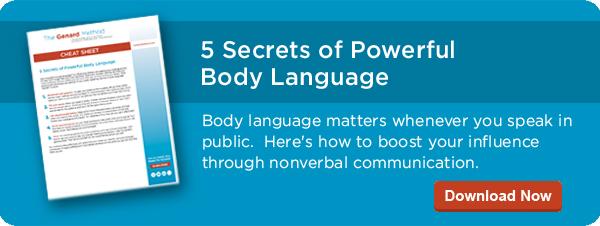Body language is a key skill in public speaking. In fact, in terms of leadership presence and charisma, some people would say it's the most important skill you possess as a speaker.
But how can you get better at it? What techniques exist to make you more a powerful speaker who uses body language and gestures effectively? The following are 6 key skills building techniques we use at Public Speaking International in Boston. They're fast, easy, proven methods for making you a more effective speaker in terms of this essential aspect of speeches and presentations.
Looking to heighten your executive presence and influence? Download my free eBook, "12 Easy Ways to Achieve Presence and Charisma" for a fast paced toor of the best best practices of high-impact public speaking.
1. Who's Looking Good? Find models of people you consider to be dynamic speakers. Observe how they use gestures fluidly and easily, and watch how they move on a stage or behind a lectern. Pay attention to how often they use their entire body to communicate! Now try to incorporate the freedom you see (though not the specific movements or gestures) as you practice in front of a mirror. And here are 10 ways to stay fully focused when you get in front of an audience.
2. Learn from the Pros. Watch a television program or movie that contains ample opportunity for "drama." Soap operas were ideal for this. Although they've most disappeared from daytime television, there are plenty of prime-time shows that are equally dramatic in terms of the emotional range they demand of the actors. Turn off the sound and just watch the physical expressions of the performers. You'll probably be amazed at how much of what is going on you can inderstand just from the stance, movement, gestures, and facial expressions of the actors. Television will also teach you some surprising ways to make your case quickly and powerfully.
3. (Re)Learn how to Breathe. Breathing correctly is a key component of effective body language and gestures. Once upon a time back in childhood, you "belly breathed" effortlessly and without self-consciousness. Learn to do so again to speak with confidence (and don't worry when your waistline expands on those inhalations)! This involves breathing with your diaphragm rather than in your throat. When you can develop the habit of breathing "from the center of who you are," you'll be freeing yourself from the shallow breathing and tightness that may be inhibiting your full movement as a speaker.
For more on how to master the art of combining your message with effective body language see my E-Learning Guide "How to Use Body Language and Gestures as a Speaker." Discover how the physical aspects of your presentations can help you succeed with audiences.
4. Smile. Practice smiling: at the start of a presentation when you greet your audience, and at appropriate moments as you speak. Very few speakers smile as often as they should. And even when discussing serious topics, you can smile any time you're speaking about solving a problem or expressing optimism. Watch Billy Crystal's film Mr. Saturday Night and you'll understand how even a eulogy can have everyone smiling warmly. Place a small mirror by your office phone and practice smiling when you talk on the telephone or give a webinar. Listeners and participants will hear the smile in your voice.
5. Become a Video Star. Tape yourself speaking or presenting with a video camera. Here's why it's important for you to work with this essential tool. Set the camera on a tripod, or have a friend or colleague do the taping. As you watch afterwards, you'll be helping to bring your subsoncscious behaviors up to your consciousness. That's where you need them to be if you're going to recognize and improve upon unwanted physical behavior. You'll know you're using effective body language when you find yourself listening to what that person (you) is saying while forgetting about anything that's happening physically. When you catch yourself responding that way, go back and watch what you were doing with your body and gestures. Whatever it was, it most likely was effective since it supported your speech without calling attention to itself. Now recreate it consciously.
6. Know Your Performance Space. Whenever possible, visit the venue where you'll be presenting. Get a sense of the space—whether it's a small room or an auditorium or anything in between—and tell yourself you're going to fill it. Walk around the performance space until you can feel your sense of physical command growing. Sit where the audience will be, and get a sense from their point of view what it will take for you to "reach out and touch them." Projecting across physical space is what using effective body language and gestures are all about!
Use these six approaches, and you'll quickly build your skills in physical performance. Combine those skills with your knowledge and dedication and you'll have the "full package" to speak to audiences with presence and power.



